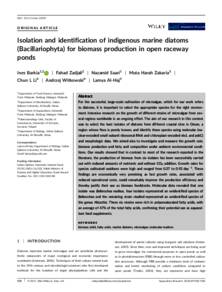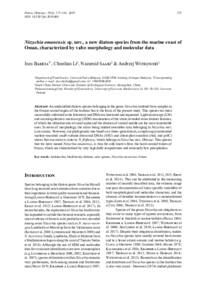وثيقة
Isolation and identification of indigenous marine diatoms (Bacillariophyta) for biomass production in open raceway ponds.
المعرف
DOI: 10.1111/are.13539
المصدر
Aquaculture Research. v. 49, 2, p. 928-938
المساهمون
Zadjali, Fahad., مؤلف
Saari, Nazamid., مؤلف
Zakaria, Muta Harah., مؤلف
Li, Chun L., مؤلف
Witkowski, Andrzej., مؤلف
Al-Haj, Lamya., مؤلف
الدولة
United Kingdom.
الناشر
Blackwell Publishing Ltd.
ميلادي
2018-02-01
اللغة
الأنجليزية
الموضوع
الملخص الإنجليزي
For the successful, large-scale cultivation of microalgae, which for our work refers to diatoms, it is important to select the appropriate species for the right environment. Intensive research on the growth of different strains of microalgae from several regions worldwide is an ongoing effort. The aim of our research in this context was to select the best isolates of diatoms from different coastal sites in Oman, a region whose flora is poorly known, and identify these species using molecular (nuclear-encoded small subunit ribosomal RNA and chloroplast-encoded rbcL and psbC) and morphologic data. We aimed also to investigate and measure the growth rate, biomass production and fatty acid composition under ambient environmental conditions. Our results showed that in contrast to most of the research reported in the literature, the production of biomass from six isolates has been successfully carried out with reduced amounts of nutrients and without CO2 addition. Growth rates for species cultivated outdoors were high and ranged from 0.37 to 0.92 day−1. These findings are economically very promising as fast growth rates, associated with reduced operational costs, could remarkably improve the production efficiency and thereby justify their use as biomass feedstocks. Molecular data revealed that one isolate was Bellerochea malleus, four isolates represented an unidentified species of Bellerochea and the remaining strain studied represented an unidentified species of the genus Nitzschia. These six strains were rich in polyunsaturated fatty acids, with an average of 47% of the total fatty acids, confirming their potential use as aquaculture feed supplements.
ISSN
1355-557X
قالب العنصر
مقالات الدوريات


